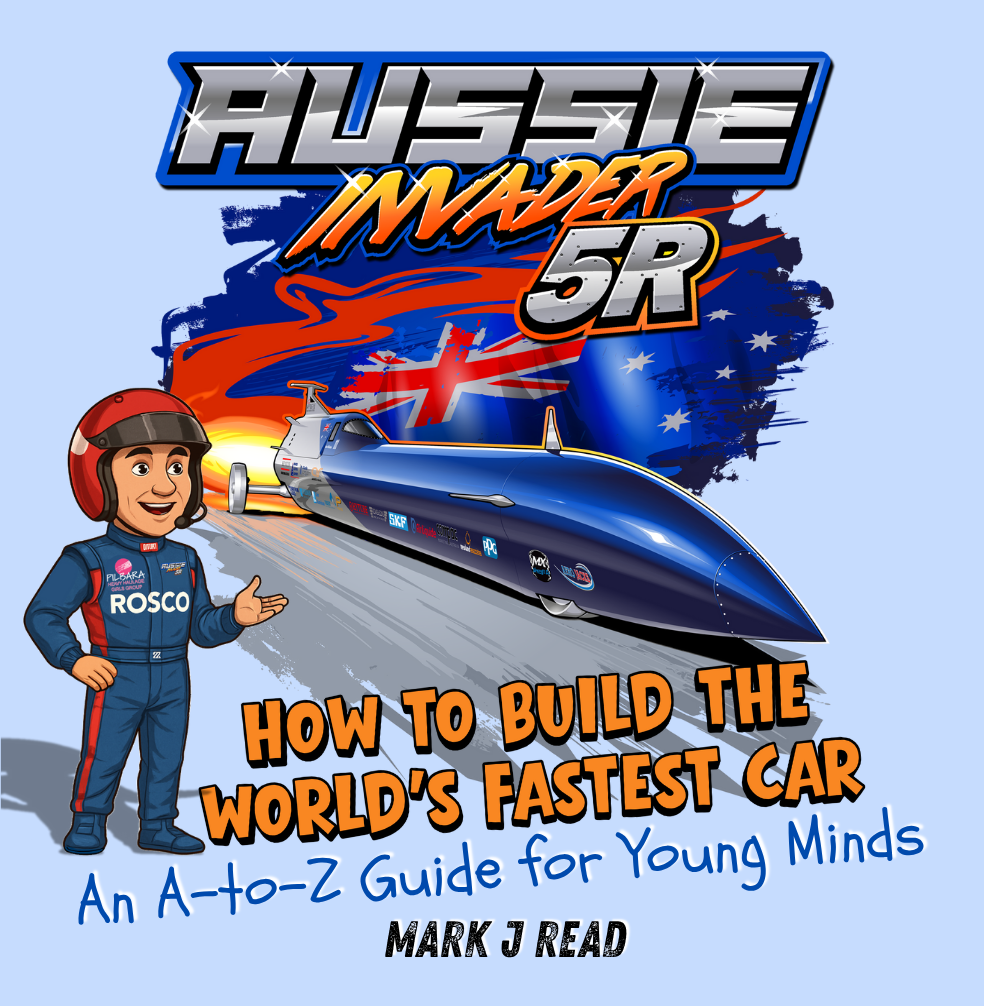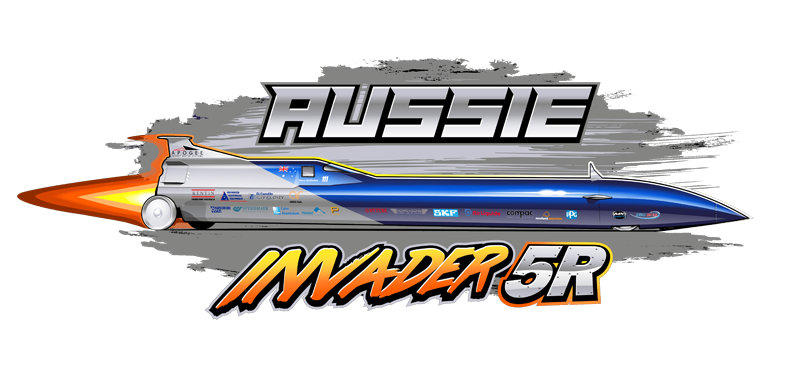Words and Terms Explained From The Book

Aero Drag
Aero drag, or aerodynamic drag, is a force that opposes an object moving through the air and slows it down. If an object is flat or has an unusual shape, it tends to have higher aerodynamic drag because air cannot flow around or over it as easily. An example of aero drag is you riding your bike into a strong wind. The stronger the wind you are riding into, the harder it is to pedal.
Aerodynamics
Aerodynamics is the study of how air moves around objects. The rules of aerodynamics explain how an aircraft can fly. Understanding aerodynamic principles was crucial in designing Aussie Invader 5R, as we want to make it as streamlined as possible and keep it on the ground. We definitely do not want it to fly like an aircraft.
Altitude
Altitude refers to the height of something, typically how far it is above the ground or sea level. The higher the altitude, the less dense the air is, because the weight of the air above it is lower. Yes, although air appears very light and floats, it does have weight. Objects can move more easily in the less dense air as you go higher up in the atmosphere.
Avionics
Avionics refers to the electronics that control aircraft electrical systems. Aussie Invader 5R will travel extremely fast and experience significant heat and vibration, so the electrical equipment will need to be very shock-resistant and built to a much higher standard than that of a normal car.
Bi-propellant
Our bi-propellant rocket uses two different liquids: a fuel and an oxidiser. When fuel burns, it needs oxygen, so we also need to carry a liquid oxidiser. The word “Bi” means two, like a bicycle, which has two wheels. We use two propellants in our rocket engine that ignite when mixed; this is called a “hypergolic” reaction.
Centre of Gravity
The centre of gravity (CG) is the point within an object where its weight is evenly balanced in all directions. Understanding its significance is important because it helps predict how an object will behave. Our centre of gravity keeps us, and other objects, from falling over.
Composite
Although we refer to carbon fibre on its own, it really should be carbon fibre composite. A composite is the combination of two materials, in this case, carbon fibre and a resin (glue). This creates a composite material that is very strong, rigid and lightweight.
Drag Coefficient
The drag coefficient (Cd) is a measure of how much an object resists movement through air or water. It’s a number that helps us understand how streamlined an object is. Lower numbers are more streamlined, and higher numbers indicate more resistance (less streamlined).
G or G-forces
G-force, or gravitational force, measures the force of acceleration and deceleration on an object, which could be your body. So, it’s how much you feel pushed or pulled when you speed up, slow down, or change direction. Two G is twice the normal force of gravity we feel standing on Earth.
Horsepower
Horsepower is an older unit of power, invented by James Watt, that compares the power of a steam engine to the strength of a horse. In some countries, it is still used to measure a car’s power. One horsepower is equal to the amount of energy it takes to lift 550 pounds one foot in one second, or 75 kilograms by 1 metre in 1 second.
Hydraulic
Hydraulics uses high-pressure oil to generate the force needed to open our air brakes at high speed and power our steering mechanism. When we open our air brakes, they will experience a force of seven tonnes of air pressure. Hydraulics allows small forces to produce large movements, such as lifting a car with a hydraulic jack.
Inert Gas
An inert gas is a gas that is non-reactive, meaning it doesn’t easily mix or form chemical bonds with other substances. You can think of them as “lazy” or “quiet” gases that prefer to stay by themselves. We use an inert gas for safety because the rocket engine’s fuel is very volatile.
Inertia
Inertia is an object’s natural tendency to keep doing what it’s already doing. If it’s sitting still, it wants to stay still, and if it’s moving, it wants to keep moving in the same direction and at the same speed. You feel inertia when a car suddenly stops, and your body keeps moving forward.
Lbf
Pounds Force (lbf) is an older unit of force in the Imperial (or U.S. Customary) system, and was often used in the U.S. in rocket thrust calculations. One lbf is the force that accelerates a one-pound mass at standard Earth gravity (32.174 ft/s²). One lbf is equivalent to 4.448 N (Newtons), the SI unit of force.
Lift
Lift is the opposite of downforce and is an upward-acting force that opposes gravity. It’s generated by the movement of air over and around an object, creating a pressure difference that results in an upward force. Some surfaces on Aussie Invader 5R may generate lift, which we must minimise to keep the car safely on the ground.
Mach 1
The Mach number is the ratio of the speed of Aussie Invader 5R compared to the speed of sound. If something is travelling at less than Mach 1, it is at subsonic speeds; at close to Mach 1, it is transonic, and at Mach 1 and above, it is at supersonic speeds.
Newtons
A Newton is the main unit of force in the SI system. It is a way to measure the strength of a push or pull. It’s named after a famous scientist, Sir Isaac Newton. One Newton is the force needed to make a mass of one kilogram accelerate at a rate of one metre per second every second.
Newton’s 1st Law
Newton’s first law of motion, also called the law of inertia, states that an object at rest will stay at rest, and an object in motion will keep moving in a straight line at the same speed, unless a force acts on it. This can be thought of as objects being “lazy” and wanting to keep doing whatever they are already doing.
Newton’s 2nd Law
Newton’s second law of motion states that the greater an object’s mass, the more force is required to accelerate it. Simply put, if you double the weight of an object and apply the same force to it, you will halve its acceleration. This is because a greater mass has more inertia and resists changes in motion more strongly.
Newton’s 3rd Law
Newton’s third law of motion explains how Aussie Invader 5R works. This means that when you push on something, it pushes back on you with the exact same amount of force, but in the opposite direction. You can see this when you push off a wall to swim, or how a ball bounces off the ground.
Playa
A playa, also known as a dry lakebed, is a vegetation-free, flat area at the lowest part of an undrained desert basin. These basins can flood during wetter periods and then evaporate, leaving behind a sun-baked, hard surface of sediment, such as clay, silt, and sand. This surface is ideal for running Aussie Invader 5R on.
Propellant
Propellant is the term used to collectively describe both the fuel and the oxidiser needed for combustion in a rocket engine. While “fuel” refers to the substance that burns, a rocket also requires an oxidiser to allow that burning process to take place. The propellant “propels” Aussie Invader 5R forward.
Radar
Radar (RAdio Detection And Ranging) uses electromagnetic waves—usually short-wavelength waves called microwaves. These waves bounce back from solid objects in their path, as sound waves do, producing echoes. We use Radar to detect objects in the distance and out of sight.
Regulators
Regulators are very important in liquid bi-propellant rocket engines. They control the flow rate of the fuel and oxidiser into the rocket engines’ combustion chamber. Regulators control the flow of propellant into the rocket engine, helping keep it operating safely and efficiently.
Rockets
In a liquid rocket, the fuel and oxidiser are stored separately and pumped into the combustion chamber where they burn. You can stop a liquid rocket by closing the valves. In a solid rocket, the chemicals are pre-mixed and packed into a cylinder. Once a solid rocket is lit, you can’t stop it. It’s like a big firework.
Subsonic
Subsonic means moving slower than the speed of sound (Mach 1). The speed of sound in air is 1,230 km/h (765 mph) at 20 °C (68 °F), as it varies with temperature and altitude. So, when you ride your bike to school, you are travelling at a subsonic speed, unless you pedal too fast. ;-)
Supersonic
Supersonic speed refers to the speed of something that can travel at or faster than the speed of sound. This means the object is moving at a rate exceeding 1,230 km/h (765 mph) at sea level, at 20 °C (68 °F).
1st Law of Thermodynamics
The 1st law of thermodynamics states that energy is conserved: it cannot be created or destroyed; it can only be transferred or changed in form. An example of this is the three braking systems on Aussie Invader 5R, which convert kinetic energy into heat through friction and sound.
2nd Law of Thermodynamics
The second law of thermodynamics states that things naturally tend to become more disordered over time. For example, your bedroom will naturally become messy unless you put energy into cleaning it. Also, no energy transfer is 100% efficient; some energy is always lost as waste heat.
Thrust-powered
Thrust-powered vehicles usually refer to aircraft and rockets. However, it is any vehicle that is powered by a jet or rocket engine. In drag racing and land speed racing, there are some cars and motorcycles that use jet and rocket engines, like Aussie Invader 5R.
Transonic
Transonic is when an object moves at speeds close to the speed of sound (Mach 1). At transonic speeds, it feels like pushing through an invisible wall. This “wall” is called the sound barrier. It happens because the air around an object starts to behave very differently in this range.
X-rays
X-rays are powerful waves of energy used in hospitals to see through objects. However, X-rays can be used to find imperfections in metal. This technique, called industrial radiography, uses X-rays to penetrate metal. We used this to inspect our aluminium solid blocks for flaws or cracks before machining.
